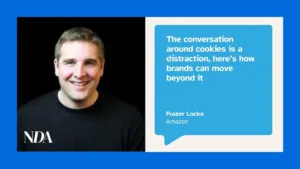Every agency and brand must make the jump into the nascent space of CTV as quickly as possible to connect with its unique, growing audiences. But you don’t need to do it alone, says Freddie Turner, MD at MiQ UK.
The TV industry is changing – it’s very clear. Linear TV is seeing increasing competition from the digital ecosystem. Meanwhile, changing audience viewing habits mean it must fight for attention against a multitude of digital options. Now, 95% of the ads shown on the platform reach only 55% of the TV audience, according to Samba TV research.
Subscription Video on Demand has been stealing the lifeblood of linear TV, while hiding its audience away from advertisers. And although the platform is pricing itself out of the market, viewers are not returning to their old friend.
Instead, audiences are making the leap to the new disruptors, the ad-driven connected TV (CTV) streaming platforms, AVOD (Advertising-based Video on Demand) and FAST (Free Ad-supported Streaming), which agencies and advertisers consider too new and are therefore reluctant to invest in.
So how do agencies and advertisers make sense of these changes and reach an increasingly elusive and fragmented, but highly lucrative, TV audience?
Time to change
It doesn’t make sense to focus solely on linear TV anymore, spending the same money or more to reach an audience that has nearly halved. The only option is to augment your TV strategy with CTV and go after as many of those non-exposed viewers as possible.
This makes advertising on AVOD and FAST imperative. Not only for agencies so they can maximise their value to their clients, but also for brands themselves looking to take their products and services to the largest relevant audience.
They may be dispersed across the growing CTV landscape, but those people who left linear TV for SVOD are re-emerging as prime advertising audiences for brands to target and re-engage with. Playing it safe on linear TV means missing out on this growing group of consumers while sticking with another group that’s shrinking.
This surely means the benefits of making investment and taking the time, and, yes, the risk to engage with this audience outweigh the drawbacks.
Clear vision
Setting out the scenario this clearly should surely help agencies ease their client brands over the psychological risk barrier. Especially if you top it with sprinkles of the following statistics to guide your point home…
- Over 67% of UK households own a smart (connected) TV
- Nearly three-quarters of people in six European countries, including the UK, now use AVOD platforms at least once a week, while almost a third use them daily according to 2022 Connected Viewers
- CTV programming is rapidly improving, with global spend on AVOD content predicted to reach US$70 billion in 2027, up from US$33 billion in 2021, according to a Digital TV Research. The UK market will follow suit.
- 16-24 year-olds are watching less than an hour (53 minutes) of linear TV a day this year on average, down over two thirds in the past decade. (Ofcom)
Write the rulebook
Once agencies and/or their brands are won over, the hard work begins. They will need to figure out how best to plan and measure ad campaigns across linear TV and ad-driven streaming platforms. With no standard approach in place, achieving this successfully demands research and collaboration across the board.
The key is putting the target consumer first and keeping an open mind. Consumers don’t differentiate between the platforms. They don’t see the TV landscape as fragmented. They only see choice in terms of content and cost. They simply watch what they want through the most affordable and convenient means in the best quality. Within reason, you need to reach them wherever they are.
Once you’ve pinned down your target audience, you’ll need to research which platforms are most appropriate. Then it’s about tapping into specialist teams with CTV knowledge and expertise to advise on the channels to consider.
When running the campaign, ideally you need to hook up with a partner that can help you coordinate the planning and execution of programmatic campaigns seamlessly and simultaneously across all channels, regardless of platforms.
To avoid reaching the same consumers across different platforms, ensure there’s an option to bring incrementalities against linear TV reach, helping plug the wastage gap without duplication. It’s also wise to kick off by investing in one or more test campaigns to show you appreciate a brand’s concerns and help build trust and confidence.
Emerging ecosystem
In terms of campaign measurement, it all comes back to data, and using it where possible to establish holistically across all the linear and CTV platforms to see what audiences are watching and through which channel. Then being able to connect that and reach them on whatever devices they are using at whatever time they are active.
When channels have sparse viewer data, techniques like automatic content recognition (ACR) can prove key to detecting what people are watching on their TV screen. ACR technology is developing all the time, enabling agencies and brands to achieve more and more – and it’s all privacy-compliant.
This will be a voyage of discovery for agencies and brands, but one that will pay dividends and help build trust and confidence in CTV, while also pushing CTV platforms to do more in terms of audience data. Rather than seeing TV’s current state as fragmented, view it as a new emerging TV ecosystem waiting to be tapped into.
Using all the knowledge, expertise and tools at your disposal through collaboration and partnerships holds the key to unlocking the door to advertising value and opportunity in this exciting evolving world.









